
Concept explainers
(a)
Interpretation:
The IUPAC name of given compound has to be assigned.
Concept Introduction:
Any organic molecule can be named by using certain rules given by IUPAC (International Union for Pure and applied chemistry). IUPAC name consists of three parts in major namely Prefix suffix and root word.
Prefix represents the substituent present in the molecule and its position in the root name.
Suffix denotes the presence of
Root word represents the longest continuous carbon skeleton of the organic molecule.
IUPAC rules for naming ether:
- ✓ The base name is found from the longest carbon chain present in ether.
- ✓ The suffix –yl has to be changed to –oxy in order to obtain the alkoxy group name. For example, ethyl becomes as ethoxy, methyl becomes as methoxy etc.
- ✓ Alkoxy name has to be placed first with the number (carbon atom to which the alkoxy group is attached) followed by the base name.
(a)
Answer to Problem 14.103EP
IUPAC name of the given compound is ethoxyethane.
Explanation of Solution
The structure of given compound is shown below,

First step is to identify the longest carbon chain. In this case it is a two carbon chain. Hence, the base name is ethane.

Next step is to identify the alkoxy group. In the given compound, the alkoxy group is found to be ethoxy as it contains two carbon atoms.
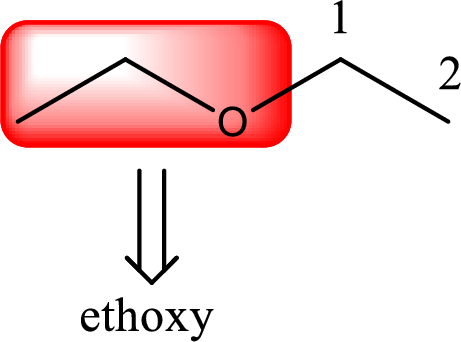
Alkoxy name is placed before the base name with the appropriate number that gives information about to which carbon atom the alkoxy group is attached. In this case as only two carbon atoms is present and hence numbering is not required. This gives the IUPAC name as ethoxyethane.
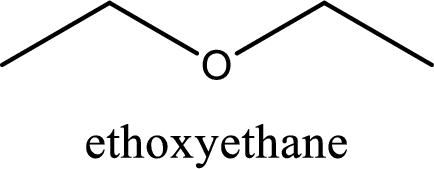
IUPAC name for the given compound is assigned.
(b)
Interpretation:
The IUPAC name of given compound has to be assigned.
Concept Introduction:
Any organic molecule can be named by using certain rules given by IUPAC (International Union for Pure and applied chemistry). IUPAC name consists of three parts in major namely Prefix suffix and root word.
Prefix represents the substituent present in the molecule and its position in the root name.
Suffix denotes the presence of functional group if any in the molecule. It can be an alkene, alkyne, alcohol, carboxylic acid, alcohol etc.
Root word represents the longest continuous carbon skeleton of the organic molecule.
IUPAC rules for naming ether:
- ✓ The base name is found from the longest carbon chain present in ether.
- ✓ The suffix –yl has to be changed to –oxy in order to obtain the alkoxy group name. For example, ethyl becomes as ethoxy, methyl becomes as methoxy etc.
- ✓ Alkoxy name has to be placed first with the number (carbon atom to which the alkoxy group is attached) followed by the base name.
(b)
Answer to Problem 14.103EP
IUPAC name of the given compound is 2-methoxy-2-methylpropane.
Explanation of Solution
Given structure of ether is,
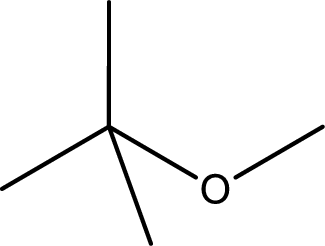
First step is to identify the longest carbon chain. In this case it is a three carbon chain. Hence, the parent
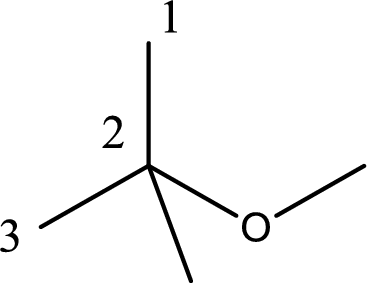
The substituent present in the longest carbon chain is a methyl group at the second carbon atom. Therefore, the base name is 2-methylpropane.
Next step is to identify the alkoxy group. In the given compound, the alkoxy group is found to be methoxy as it contains only one carbon atom.
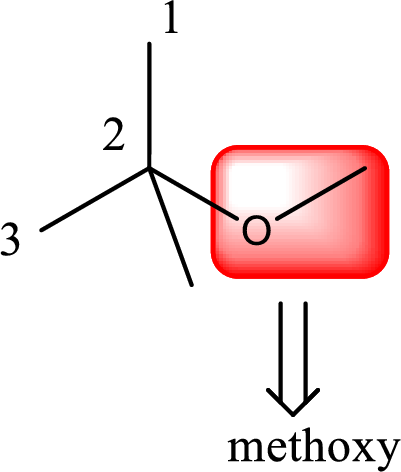
Alkoxy name is placed before the base name with the appropriate number that gives information about to which carbon atom the alkoxy group is attached. This gives the IUPAC name as 2-methoxy-2-methylpropane.
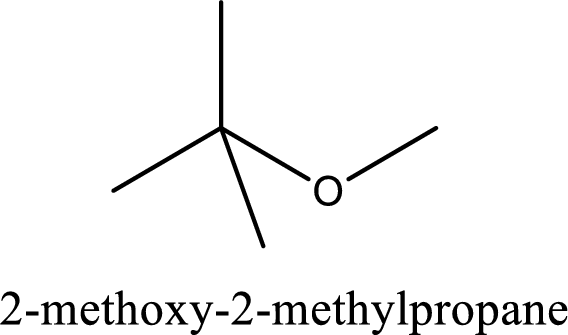
IUPAC name for the given compound is assigned.
(c)
Interpretation:
The IUPAC name of given compound has to be assigned.
Concept Introduction:
IUPAC rules for naming alcohols that contain single hydroxyl group:
- • Longest carbon chain has to be identified that contains hydroxyl group also. The chain name is obtained by replacing the letter “-e” in alkane with “-ol”. If the compound contains a unsaturated bond, then the respective name has to be changed with regard to alkane.
- • The numbering has to be given so that the hydroxyl group gets the least numbering.
- • Name and location of any other substituent present in the chain has to be identified.
- • If in a ring the hydroxyl group is present, then that carbon is numbered 1 and the numbering then proceeds counterclockwise or clockwise in a way that substituents present if any gets the least numbering.
- • Hydroxyl group as a substituent in a molecule is named as hydroxy group rather than hydroxyl group.
- • If the compound contains bulky groups on same side of the double bond, then it is a cis isomer and if the bulkyl groups are present on opposite side of the double bond, then it is a trans isomer.
- • In case of cycloalkane compounds, if the substitutions are present on same side of the ring of carbon atoms, it is a cis isomer. If the substitutions are present above and below the ring, then it is a trans isomer.
IUPAC rules for naming alcohols that contain more than one hydroxyl group:
- • The same rules said above is followed but the prefix di-, tri-, tetra etc is added corresponding to the number of hydroxyl groups that is present.
(c)
Answer to Problem 14.103EP
IUPAC name of the given compound is methoxymethanol.
Explanation of Solution
The structure of given compound is shown below,

The given compound has two functional group namely, hydroxyl group and a alkoxy group. Alcohol has got more preference over ether. Therefore, the IUPAC name is given by using the parent as alcohol. In this case the parent alcohol is found to be methanol. The substituent that is present in the methanol is a methoxy group. Therefore, the IUPAC name of the given compound can be written as methoxymethanol.
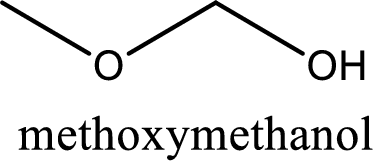
IUPAC name for the given compound is assigned.
(d)
Interpretation:
The IUPAC name of given compound has to be assigned.
Concept Introduction:
Any organic molecule can be named by using certain rules given by IUPAC (International Union for Pure and applied chemistry). IUPAC name consists of three parts in major namely Prefix suffix and root word.
Prefix represents the substituent present in the molecule and its position in the root name.
Suffix denotes the presence of functional group if any in the molecule. It can be an alkene, alkyne, alcohol, carboxylic acid, alcohol etc.
Root word represents the longest continuous carbon skeleton of the organic molecule.
IUPAC rules for naming ether:
- ✓ The base name is found from the longest carbon chain present in ether.
- ✓ The suffix –yl has to be changed to –oxy in order to obtain the alkoxy group name. For example, ethyl becomes as ethoxy, methyl becomes as methoxy etc.
- ✓ Alkoxy name has to be placed first with the number (carbon atom to which the alkoxy group is attached) followed by the base name.
(d)
Answer to Problem 14.103EP
IUPAC name of the given compound is 2-methylanisole.
Explanation of Solution
The structure of given compound is shown below,
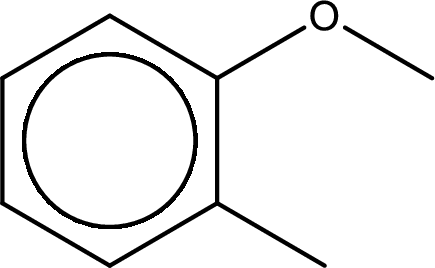
First step is to identify the longest carbon chain. In this case it is a six carbon
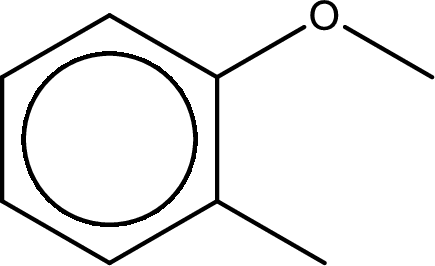
Next step is to identify the substituent present in the given structure. It is found that a methyl group is present in the second carbon atom of the aromatic benzene ring.
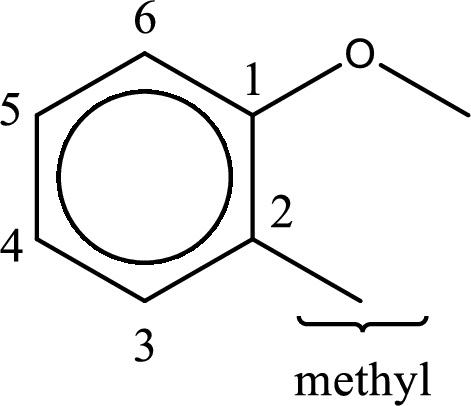
The substituent methyl group is present on the second carbon atom. The parent compound name is anisole (methoxybenzene). This gives the IUPAC name as 2-methylanisole.
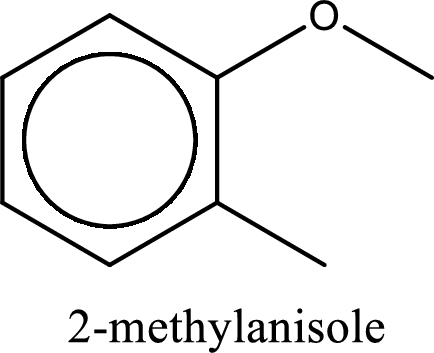
IUPAC name for the given compound is assigned.
Want to see more full solutions like this?
Chapter 14 Solutions
Bundle: General, Organic, and Biological Chemistry, 7th + OWLv2 Quick Prep for General Chemistry, 4 terms (24 months) Printed Access Card
- Draw the titration curve of (i) weak acid vs. strong base; (ii) weak acid vs. weakbase; (iii) diprotic acid with strong base (iii) triprotic acid with strong base.arrow_forwardComplete the reaction in the drawing area below by adding the major products to the right-hand side. If there won't be any products, because nothing will happen under these reaction conditions, check the box under the drawing area instead. Note: if the products contain one or more pairs of enantiomers, don't worry about drawing each enantiomer with dash and wedge bonds. Just draw one molecule to represent each pair of enantiomers, using line bonds at the chiral center. More... No reaction. my ㄖˋ + 1. Na O Me Click and drag to start drawing a structure. 2. H +arrow_forwardPredict the intermediate 1 and final product 2 of this organic reaction: NaOMe H+ + 1 2 H H work up You can draw 1 and 2 in any arrangement you like. Note: if either 1 or 2 consists of a pair of enantiomers, just draw one structure using line bonds instead of 3D (dash and wedge) bonds at the chiral center. Click and drag to start drawing a structure. X $ dmarrow_forward
- Predict the major products of this organic reaction: 1. NaH (20°C) 2. CH3Br ? Some notes: • Draw only the major product, or products. You can draw them in any arrangement you like. • Be sure to use wedge and dash bonds where necessary, for example to distinguish between major products that are enantiomers. • If there are no products, just check the box under the drawing area. No reaction. Click and drag to start drawing a structure. G Crarrow_forwardPredict the major products of this organic reaction: 1. LDA (-78°C) ? 2. Br Some notes: • Draw only the major product, or products. You can draw them in any arrangement you like. . • Be sure to use wedge and dash bonds where necessary, for example to distinguish between major products that are enantiomers. • If there are no products, just check the box under the drawing area. No reaction. Click and drag to start drawing a structure. Xarrow_forwardPlease draw the structuresarrow_forward
- Draw the missing intermediates 1 and 2, plus the final product 3, of this synthesis: 0 1. Eto 1. Eto- 1 2 2. MeBr 2. EtBr H3O+ A 3 You can draw the three structures in any arrangement you like. Explanation Check Click and drag to start drawing a structure.arrow_forwardDraw the missing intermediate 1 and final product 2 of this synthesis: 1. MeO- H3O+ 1 2 2. PrBr Δ You can draw the two structures in any arrangement you like. Click and drag to start drawing a structure.arrow_forwardWhat is the differences between: Glyceride and phosphoglyceride Wax and Fat Soap and Fatty acid HDL and LDL cholesterol Phospho lipids and sphingosine What are the types of lipids? What are the main lipid components of membrane structures? How could lipids play important rules as signaling molecules and building units? The structure variety of lipids makes them to play significant rules in our body, conclude breifly on this statement.arrow_forward
- What is the differences between DNA and RNA for the following: - structure - function - type What is the meaning of: - replication - transcription - translation show the base pair connection(hydrogen bond) in DNA and RNAarrow_forwardWhat is the IP for a amino acid- give an example what are the types of amino acids What are the structures of proteins The N-Terminal analysis by the Edman method shows saralasin contains sarcosine at the N-terminus. Partial hydrolysis of saralasin with dilute hydrochloric acid yields the following fragments: Try-Val-His Sar-Arg-Val His-Pro-Ala Val- Tyr- Val Arg-Val-Tyr What is the structure of saralasin?arrow_forwardWhat is the IP for a amino acid- give an example what are the types of amino acids What are the structures of proteins The N-Terminal analysis by the Edman method shows saralasin contains sarcosine at the N-terminus. Partial hydrolysis of saralasin with dilute hydrochloric acid yields the following fragments: Try-Val-His Sar-Arg-Val His-Pro-Ala Val- Tyr- Val Arg-Val-Tyr What is the structure of saralasin?arrow_forward
 General, Organic, and Biological ChemistryChemistryISBN:9781285853918Author:H. Stephen StokerPublisher:Cengage Learning
General, Organic, and Biological ChemistryChemistryISBN:9781285853918Author:H. Stephen StokerPublisher:Cengage Learning Organic And Biological ChemistryChemistryISBN:9781305081079Author:STOKER, H. Stephen (howard Stephen)Publisher:Cengage Learning,
Organic And Biological ChemistryChemistryISBN:9781305081079Author:STOKER, H. Stephen (howard Stephen)Publisher:Cengage Learning,


